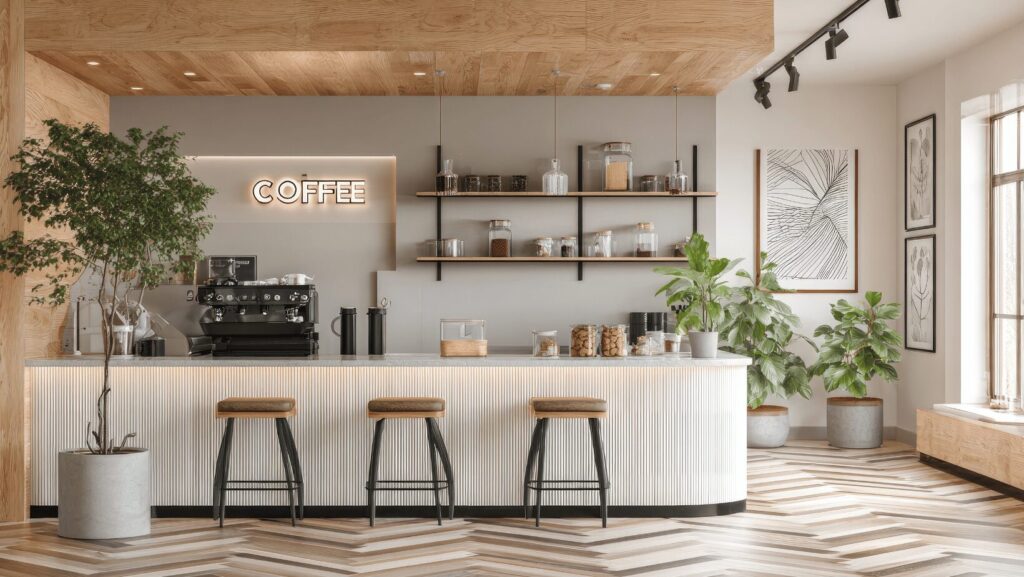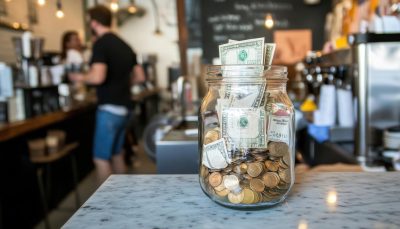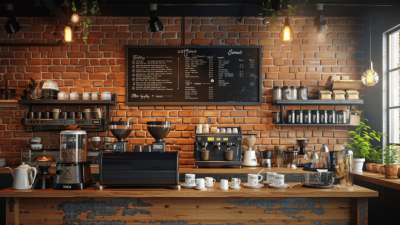For new customers, your cafe’s interior is what dictates their first impression.
So, if you want that first impression to be a good one — and if you want customers to feel warm and welcomed in your space — you need to design a cafe interior that creates those feelings.
In this blog, we’ll take you through the basics of cafe interior design, including:
- High-level considerations for cafe interiors (and how they differ from restaurants)
- How much you “should” spend on your cafe interior design, and the options you have
- Five tips to help guide your design efforts, making your cafe interior the best it can be
Let’s dive in.
What’s the difference between a cafe interior and a restaurant interior?
Cafes and restaurants are similar in that they both serve food and drinks.
However, there are a few key differences between the focus of each business that mean a cafe interior and a restaurant interior aren’t designed the same.
| A cafe interior is designed around flexibility You can grab ‘n’ go, sit and socialize with friends, or set up solo to do some remote work. | A restaurant interior is designed around flow Every design choice needs to support how diners, front-of-house, and back-of-house staff flow around the room. |
| A cafe interior is designed to be open and casual There are no “rules” about how many people can sit at a table or whether you have to sit with a specific party. | A restaurant interior is designed to be more structured Even if the restaurant has casual vibes, seating is typically more rigid at restaurants than at cafes. |
| A cafe interior is designed to prioritize community Cafes are often seen as a social space, where talking across tables or striking up a conversation with a stranger isn’t out of the ordinary. | A restaurant interior is designed to be more private. Restaurants are usually focused more on keeping tables separate, ensuring each individual party has an enjoyable experience on their own. |
How much should you spend designing your cafe interior?
The “right” amount to spend on designing (or redesigning) your cafe interior depends on the budget you set out in your business plan for interior design.
And, depending on what that budget is, you’ve got a few options.
You can DIY your cafe interior
DIY is the cheapest option money-wise, because you don’t have to pay for labor or consultation, but the most expensive time-wise, because you’ll be doing everything yourself. If you don’t have a huge budget for cafe interior design — or you’re not sure you’ll want the same look forever — this is definitely the best choice.
You can work with a design consultant
Working with a design consultant is a good middle-ground option because it gives you access to an interior designer’s expertise and guidance without having to pay for them to do the entire thing for you. This is a good mid-range option if you’re okay with DIY’ing the big stuff, but want expert-level design insight and suggestions.
You can hire a professional interior designer
This option has the opposite payoff DIY does: it’s the most expensive money-wise, but can be the cheapest and most efficient time-wise. Working with a professional designer means you get to play the consultant role, collaborating on ideas, preferences, and suggestions, while the designer does most of the heavy lifting (literally and figuratively).
5 tips for designing your cafe interior
Tip 1: Put layout before aesthetics
✔ Function always needs to come first. Aesthetics are nice, but a functional cafe interior is a must. Because, in reality, a poorly designed cafe interior can ruin the experience — no matter how pretty the wallpaper or chairs look.
✔ Use floor plans to maximize flow. Before you commit, plan it out! Make sure the interior seamlessly flows from the entrance to the front counter to the seating area(s). Free tools like Canva and SketchUp can help with this, too.
✔ Plan for every room. A cafe typically has a front-of-house area (front counter and seating), a back-of-house area (prep area and kitchen), a storage room(s), and a restroom. Make sure your plans account for all of it!
Tip 2: Keep things cohesive and balanced
✔ Stick to the 70/30 Rule. Designers suggest that 70% of an interior space should be one style, theme, or color palette, while the other 30% can be a complementary style, theme, or color palette, which is a good rule of thumb!
✔ Keep big-ticket items neutral. Sticking to neutral colors like black, white, and beige for big items like countertops and flooring gives you a good base to play with. Then, you can get as creative (and bold) as you like with other decor!
✔ Consider scale and proportion. If you’ve got a small space, oversized furniture can throw the whole design off (and vice versa if you’ve got a big space with tiny pieces). Choose furniture proportional to your space for a cohesive look.
Tip 3: Stretch your budget where you can
✔ Repurpose and upcycle furniture. Check places like Facebook Marketplace, Goodwill, and other second-hand stores for things that don’t necessarily need to be brand-new, like chairs and decor. You might even get lucky with a near-new condition find!
✔ Use cheaper alternatives if possible. Some cafe interior pieces are worth spending money on, but others might not matter as much. Peel-and-stick wallpaper or paint, for example, can work just as well as “real” wallpaper but for a fraction of the price.
✔ Stop when things feel done. The average cost to furnish a coffee shop ranges from $15K to $45K. But, if you get to a point in your interior design journey where things feel done, it’s okay to stop! You don’t have to spend your entire budget if you’re happy with where you’re at.
Tip 4: Keep things light and bright
✔ Choose colors that open up the space. Light colors like white, cream, and soft grays can make your cafe interior feel bigger. This can really help open things up, especially if you’re working with a smaller, more compact space.
✔ Figure out what lighting is best for you. If your cafe has big windows, natural light is always the best for keeping things airy and fresh. But, if you need to lean more heavily on artificial light, pick a color temperature that works best for your wants and needs.
✔ Focus on finding balance. Your cafe interior shouldn’t feel as dark as the inside of a cave, but it also shouldn’t feel as bright as an operating room. A balanced lighting situation is key to a cafe interior that feels welcoming and warm.
Tip 5: Let Your Brand Shine Through Decor
✔ Add personal touches throughout the space. Your cafe is first and foremost your business, so don’t be afraid to show your personality! A cafe interior with photos and other personal touches can create an emotional connection — whether they follow design principles or not.
✔ Use decor that represents you and your brand. Your cafe interior should feel representative of your brand, so don’t be afraid to showcase your logo, accent with your brand colors, or make other design choices that are on-brand.
✔ Create a fun, social-ready “feature” space. Whether it’s an instantly recognizable neon sign or a super cozy corner with eye-catching art, creating a signature space or feature in your cafe interior can get people excited to visit — and to share your space on their socials.




